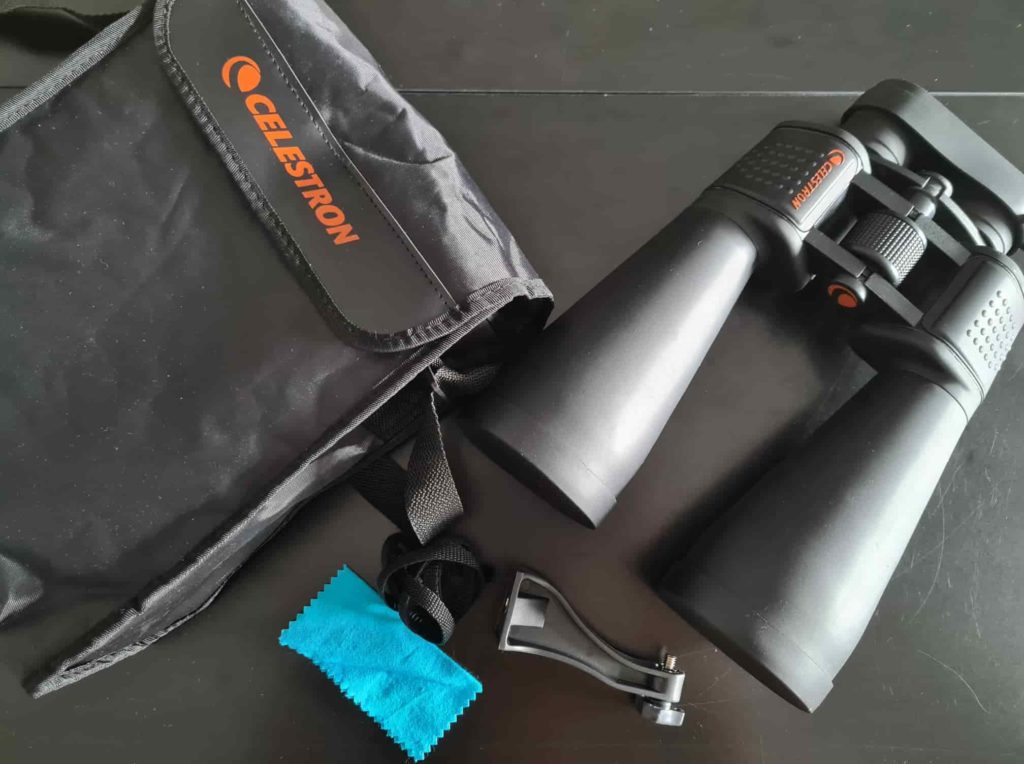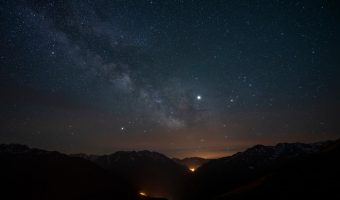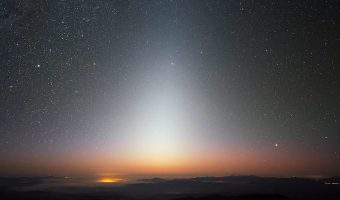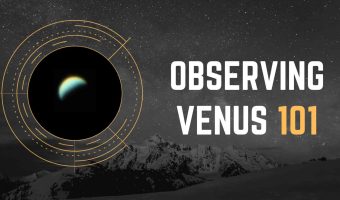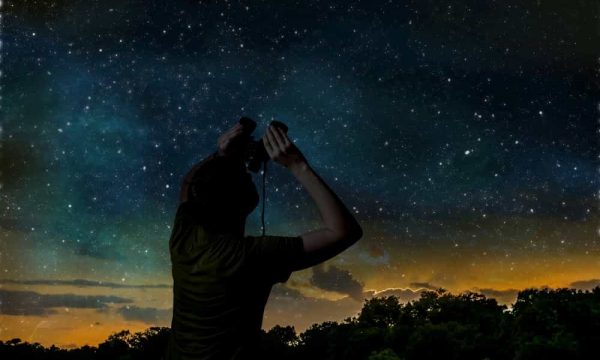
6 space objects you can easily see with binoculars
Last Updated: June 24, 2021
Using binoculars for stargazing is a fairly inexpensive way to observe many celestial objects with your own eyes. If you’ve just purchased your first pair of binoculars, you might be very excited at the idea of going out tonight and have a look at some incredible space objects.
I’ve owned a pair of Celestron Skymaster 15×70 for over four years and love to use them whenever the opportunity arises under the dark sky. However, if you are new to the hobby, finding a specific target can be tricky if you don’t know your way around the night sky. You might not know what to look at and where to find it. So to make your life easier, we’ve compiled a list of 6 objects you can easily observe through your astronomical binoculars. Enjoy the list and happy stargazing!
Table of content
1. The Moon
The sight of our closest celestial neighbor has fascinated mankind for millennia. Its appearance changes slowly over the course of a month. Sometimes, during a total lunar eclipse, the Moon takes on a blood-red appearance. It can easily be seen with the naked eye, but observing it with binoculars allows the user to see a lot more surface details
Where is it in the night sky?
The Moon is the easiest object to find in the night sky. The light coming from the Sun bounces off the surface and turns this giant ball of rock into a bright luminous disk that illuminates our night sky. While the moon isn’t necessarily an astrophotographer’s best friend, it’s without a doubt a wonderful object to observe with astronomy binoculars.
What does the Moon look like through binoculars?
Any type of binoculars (either roof prism or Porro prism) will greatly enhance your observations and provide a zoomed-in view of the moon. You will be able to see many surface details: broad plains, countless craters, deep valleys and mountain ranges.
When is the best time to observe it?
Contrary to popular belief, the best time to observe the Moon is not when it is full. That’s because the brightness of the moon will prevent you from distinguishing the different landscape features. Observing a gibbous moon (when it is either waxing or waning) provides the best opportunities to see the moon’s craters in high relief, thanks to that line (called the terminator) that separates the illuminated side of the moon from the shadowed side.
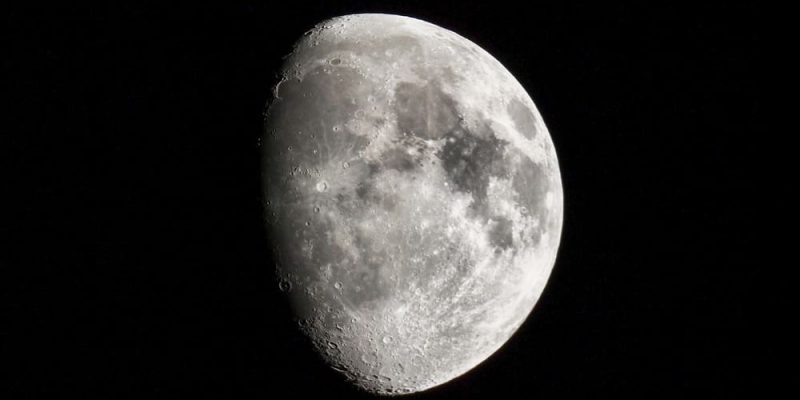
The moon in the night sky.
2. The planets
When observing the planets, a pair of binoculars is not necessarily what comes to mind first. Dobsonian telescopes are one of the best types of telescopes for planetary observations. However, an 8-inch model can be a steep investment for someone with no stargazing experience so binoculars are a great way to attempt planetary observations without breaking the bank.
Where are they in the night sky?
The planets are fairly easy to locate thanks to the many stargazing applications available to download on smartphones. Enter the name of the planet you’d like to see in the search bar, and the app will show you its exact location in the night sky.
For best results, it is best to wait until the chosen planet is high up in the night sky, say approximately 25 degrees or more above the horizon.
What does the planet look like through binoculars?
Mars will look like a fuzzy reddish ball of light. You won’t be able to make out any surface features such as the polar ice cap but the sight is nonetheless great, especially when the planet is in opposition.
Jupiter has a distinct shape, ever so slightly pushed at the top and the bottom due to its rapid spinning. If you manage to hold your binoculars steady, and granted you have a steady atmosphere above you, you should be able to see 4 very faint dot: these are the Galilean moons!
Saturn has a distinctly elliptical shape due to its rings. Binoculars are unfortunately not powerful enough to show the separation between the rings and the planet. However, if you have a binocular tripod, and the night is clear of any atmosphere turbulence, you may be able to see Saturn’s largest moon Titan.
When is the best time to observe them?
Some of the best times to observe planets in the night sky with your binoculars occur when they are at opposition. The opposition is the moment when Earth is positioned exactly between the planet and the Sun.
During this period, the planets appear at their maximum size and brightness, and they are visible above the horizon for most of the night. For Jupiter and Saturn, this happens almost once a year. Mars is at opposition about once every 2,5 years.
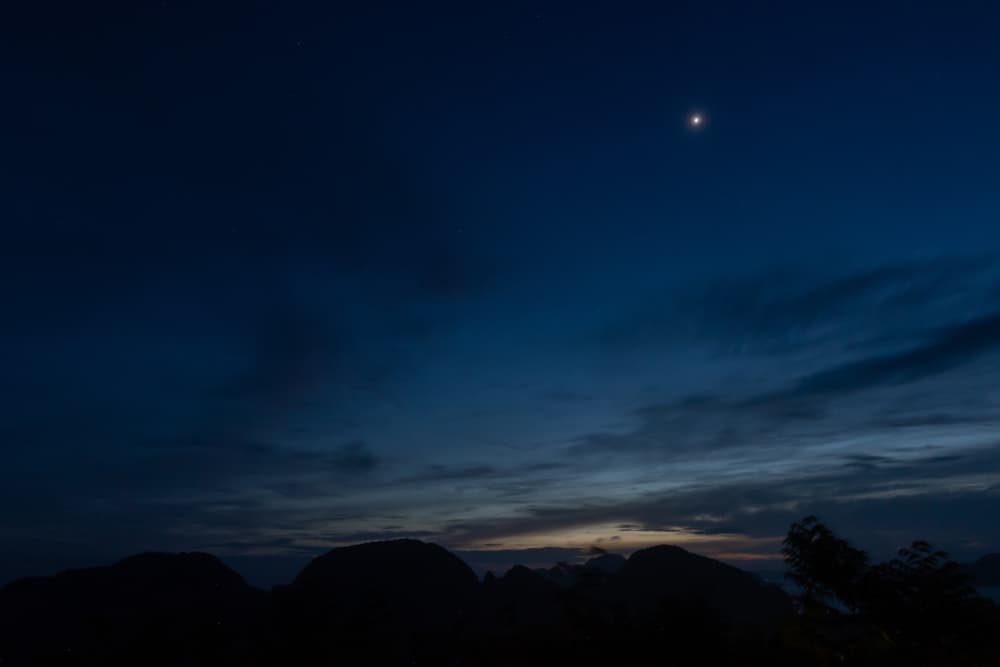
Venus shines brightly during sunset, closely following the sun into the horizon.
3. The International Space Station (ISS)
The ISS is a scientific laboratory orbiting the Earth where scientists and astronauts conduct experiments in a microgravity environment. It orbits the planets every 90 minutes, or about 16 times a day.
Where is it in the night sky?
The ISS travels very fast. To be able to observe the station, you will need to use an application or a dedicated website that will predict the next time the ISS will fly over your area. Check out our article on how to find the ISS in the night sky.
What does the ISS look like through binoculars?
Through a 15×70 pair of binoculars, the ISS looks like a rectangular shaped star rising from the western horizon, travels across the sky for up to 5 minutes (sometimes as short as 30 seconds) before diving into the eastern horizon. It’s a pretty cool sight especially knowing that there are people living up there!
When is the best time to observe it?
It’s possible to observe it multiple time per week. You just need to check your astronomy app regularly. It is said that there is at least one great pass (long and bright) every 6 weeks for any given location on earth.
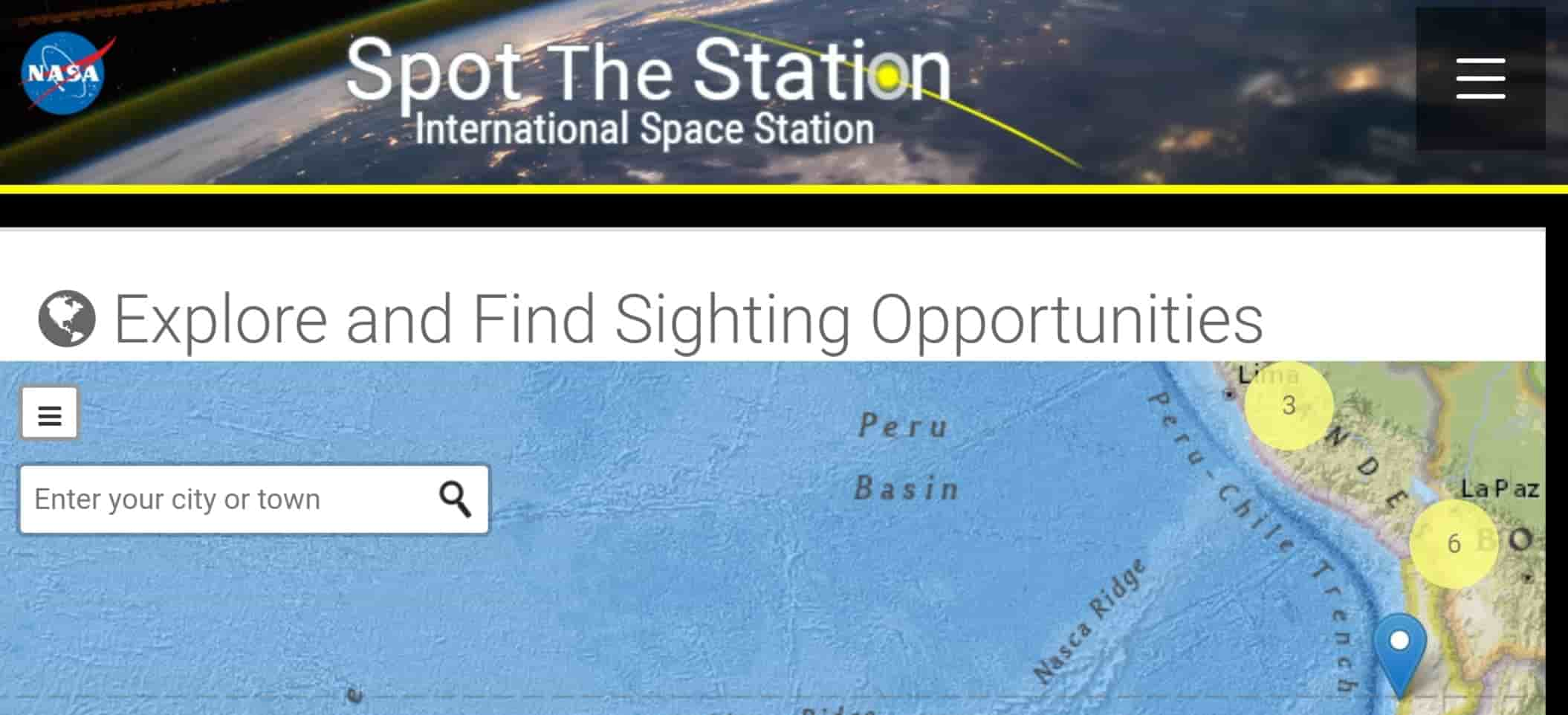
"Spot the station" is a handy tool created by NASA: https://spotthestation.nasa.gov/
4. The Andromeda Galaxy (Messier 31)
The Andromeda galaxy is a great spiral galaxy that’s twice the size of the milky way. It is also the closest major galaxy to us… and it’s actually on a collision course with our own galaxy! Not to worry, this won’t happen for billions of years. In the meantime, this galaxy is a great celestial object to seek out with binoculars.
Where is it in the night sky?
Start by locating the Pegasus constellation. Part of the constellation looks like a giant square. From the top left corner of the square extends two lines made of 3 stars. Follow the lines up until the second stars then go up until you see the infamous hazy oval in the sky.
Celestial coordinates: RA 00h 42m 44.3s | Dec +41° 16′ 9″
What does the Andromeda galaxy look like through binoculars?
This might surprise you, but the Andromeda galaxy is actually a very large deep-sky object. It’s actually 6 times the width of the moon in the sky… It’s just too dim for our eyes to see it! Through a pair of binoculars, the Andromeda galaxy looks like a slightly oval grey misty patch. Even if the sight of it won’t blow you away, it’s still pretty amazing to be able to get a glimpse of another galaxy from your backyard.
When is the best time to observe it?
From the northern hemisphere, the prime time to observe the Andromeda galaxy is during the fall and winter months (from September to March). In September and October, it rises up after sunset and reached its highest point in the sky before midnight. An ideal time if you don’t wish to stay up too late!
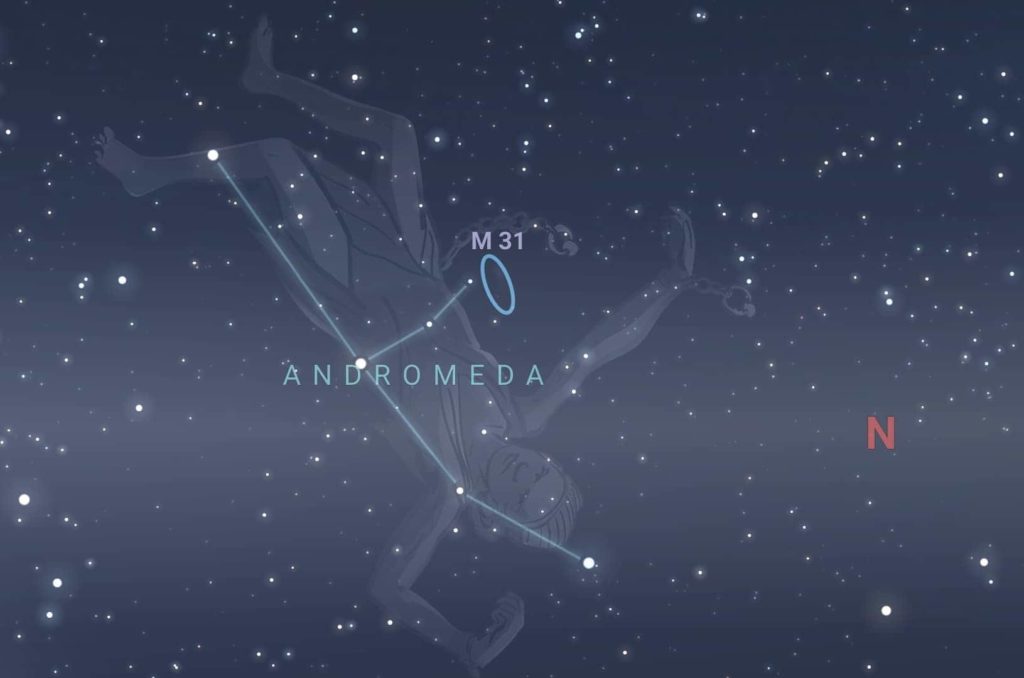
Messier 31 is located in the Andromeda constellation. Image Source: Stellarium
5. The Orion Nebula (Messier 42)
The Orion Nebula is a diffuse nebula and probably one of the most popular items from the infamous list of observable deep-sky object, the messier catalog.
Where is it in the night sky?
The Orion Nebula resides inside the set of three stars that make up the sword of Orion. The sword is the faintest part of the constellation. To find it, you should start by locating the Orion belt, a set of 3 bright stars. Look at the leftmost star (from the northern hemisphere) and slowly go down until the nebula enters your field of view.
Celestial coordinates: RA 05h 35m 17.3s | Dec −05° 23′ 28″
What does the Orion Nebula look like through binoculars?
The Orion nebula looks like a little smudge with a faint white glow. It looks really distinct from the stars that surround it, you can really see the hint of nebulosity. Almost like a small cloud with a white hue. Its appearance makes it one of the easiest deep skies objects to find with a pair of binoculars.
When is the best time to observe it?
In the northern hemisphere, the best time to see the Orion Nebula is during the winter. In December and January, the nebula is located high up in the night sky, which is the perfect opportunity to see it in all its glory.
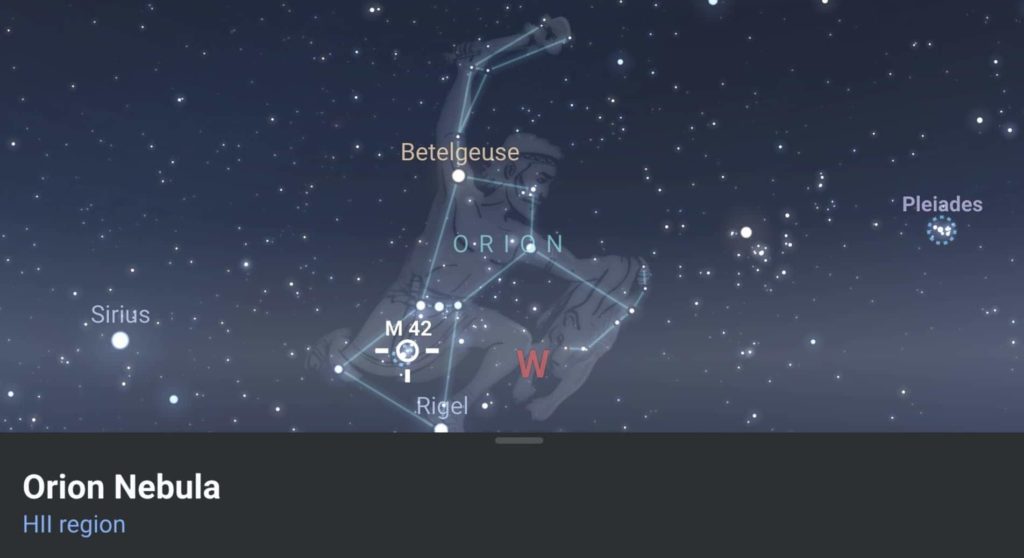
Messier 42 is located in the Orion constellation. Image Source: Stellarium
6. The Pleiades star cluster (Messier 45)
The Pleiades, also known as the seven sisters, is a beautiful open cluster made of more than 800 stars located near the Taurus constellation. It is bright enough to be seen with a pair of astronomical binocular. This celestial target is fairly popular for budding astronomer because it is fairly easy to locate it and it looks amazing in the eyepiece.
Where is it in the night sky?
The Pleiades are fairly easy to find as it’s pretty close to the Orion constellation. Start by finding Orion’s belt which is made of three stars. With your naked eyes, follow the stars from left to right as if they were forming a line to reach the red star Aldebaran. From Aldebaran, continue to look upward in the same direction and you should be able to see a group of blue stars.
Celestial coordinates: RA 3h 47m 24s | Dec +24° 7′ 0″
What does the Pleiades look like through binoculars?
The Pleiades looks like a firework display except it’s made of stars! The star clusters really stand out in the field of view with three-dimensional relief. If your eyes are well adapted to the dark and there is no light pollution in the sky, you may even distinguish the beautiful blue hue that usually shows up when you look at the seven sisters with a telescope.
When is the best time to observe it?
In the northern hemisphere, the Pleiades are visible from October to April. In November, the star cluster is visible all night long and reaches its highest position in the sky, which provides the best conditions to observe it.
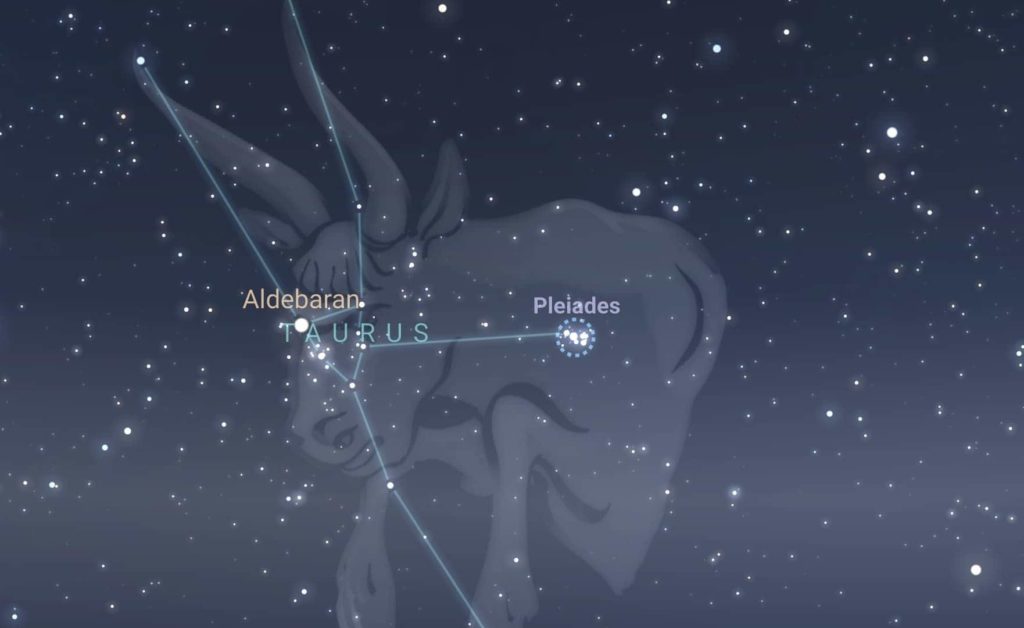
Messier 45 is located in the Taurus constellation. Image Source: Stellarium
Summary
Binoculars might not be as powerful as telescopes with larger aperture but they can definitely be a great starting point for beginners wanting to start stargazing as a hobby. They are easy to transport, require very little maintenance and do not involve lengthy set-ups. Astronomy binoculars are a great tool for learning your way around the night sky and getting familiar with visual astronomy. I still own a pair myself that I use quite often for short observing sessions or when I’m travelling.

I have been an avid stargazer for over 15 years. The night sky is a treasure trove of celestial wonders that I will never stop looking up to. From planets and galaxies to nebulae, I feel incredibly lucky to have been able to observe them with my own eyes, and I hope to help others do the same.
Wow! There's more to read 🚀
This page is part of our collection of articles about stargazing. If you enjoyed the read, then you’ll love the following articles.
When you look up into the night sky, you might have noticed that not all the stars shine equally.
The zodiacal light, also known as “False Dawn” is a triangle-shaped faint glow that can sometimes be seen shortly after sunset or before dawn.
Most of the time, Venus is the third brightest celestial object after the moon and the sun!

